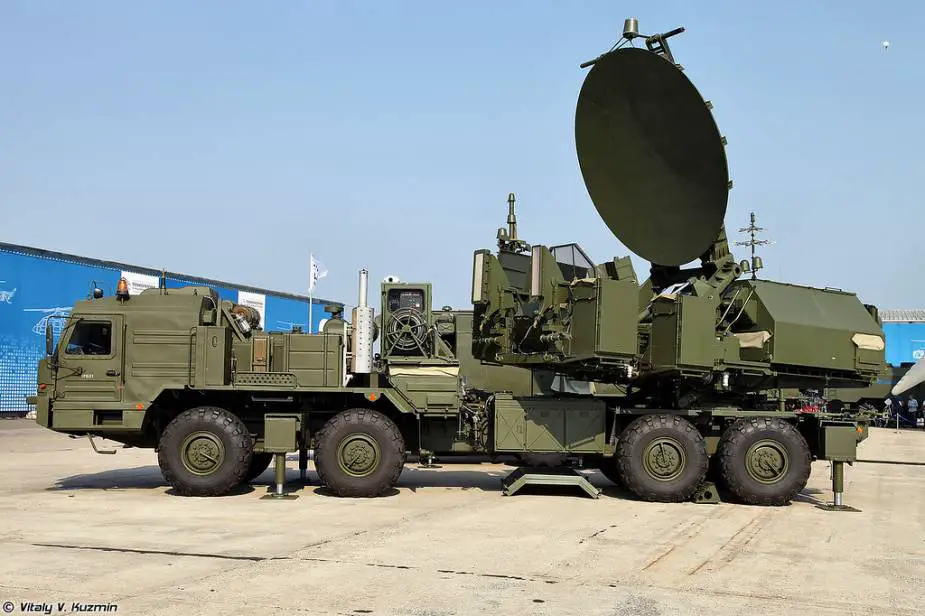Russia needs common counterdrone concept – Part 4
The design of counterdrone weapons targets each particular vehicle depending on its operational principle. The weapons have to detect, identify drones, and destroy or jam them. There is no information about a common counterdrone system in scientific literature. A specific subsystem of the fight against small drones is considered only for the air defense of the land forces. It is proposed to include into it reconnaissance and information, combat control, antiaircraft and artillery forces, and an array of specialized antiaircraft weapons with missile and technical provision.
Follow Army Recognition on Google News at this link

1L269 Krasukha-2 ECM station (Picture source: Vitaly Kuzmin)
The formations armed with the tools have to create temporary specialized antiaircraft missile and artillery groups to fight drones in expected places of their engagement. However, the specialized groups are inappropriate, as hostile drones operate in the whole area of the land formation rather than in selected places. Besides, the antiaircraft forces have to defend the troops against all air weapons, not only drones.
Drone fight is not only the business of the air defense of the land forces. Therefore, counterdrone units have been formed according to the Syrian experience in military districts and bases in Kirgizia and Tajikistan. They are armed with Krasukha, Murmansk-BN, Borisoglebsk-2 and other systems. The units have to defend specific facilities against drone reconnaissance and strikes. However, a limited number of specialized units cannot protect all the necessary objects, including air defense facilities against swarms of drones. The complexes are effective, but expensive and demand a lot of highly skilled electronic warfare operators.
In January 2018, the National Guard began to pay attention to the counterdrone fight. Groups to test weapons against unmanned aerial vehicles were created in commando units. Units to intercept unlicensed drones over the capital city were created in Moscow (all flights of private drones are banned over Moscow). The units are armed with drones to monitor objects and events, as well as devices to jam control of illegal drones operating at a distance of 600 meters.
Thus, disorganized design of a big number of tools, calls to create specific counterdrone tools, the creation of autonomous counterdrone units in various departments show that Russia does not have a common view on the fight against drones. It distracts funds and skilled specialists to specific tasks, which do not resolve the common task of the counterdrone fight.
It would be appropriate to launch research and draft a common national concept of the counterdrone fight. It has to formulate dangers and threats from drones; the goals and tasks of fighting them in peacetime, in the period of aggression threat, and in a war; the engagement of forces and provisions to create a counterdrone system; requirements and principles of engagement of tools against drones; guidelines of further development of the counterdrone system.
The concept and roadmap have to consider the provisions resulting from an analysis of the fight against drones. Firstly, as drones are engaged only in the airspace and change the combat methods in it, the fight against them should be entrusted to the Aerospace Forces, while the counterdrone concept should be a part of the general system of the national aerospace defense and the armed forces. The list of objects to be protected by the aerospace defense against drones during a war, in the period of threat and in peacetime should be expanded. Specialized units in air defense formations of the Aerospace Forces should be created.
Secondly, a single body in the country should be in charge of the counterdrone fight. Although the National Guard and the Federal Bodyguard Service are in charge of security of government bodies and mass events, they should not deal with counterdrone issues. There should be one entity in charge of the aerospace defense of the country and the armed forces, which controls the engagement of aerospace troops in various missions. The National Guard and the Bodyguard Service should interact with air defense units assigned to defend objects and events against drones.
Thirdly, the growing strength of relatively cheap hostile drones that can be used against Russia, the character of their operations and the growing number of objects and mass events to be protected in peacetime call to change the armaments of the single air defense system, mostly the antiaircraft troops of the Aerospace Forces by increasing the share of medium, short and close-range weapons and delivering a major number of specialized electronic, laser, beam and other counterdone tools.
Fourthly, it is necessary to stop the non-systemic design of specialized tools to destroy and jam drones. The counterdrone concept should provide requirements and a list of tools, organize procurement and further design.
It means systemic fight against drones can be promoted only by measures of the national scope and in the framework of the general aerospace defense system, Colonel PhD Military Science V. Tikshaev and Retired Lieutenant-General PhD Military Science V. Barvinenko write in the Military Thought magazine.
© Copyright 2021 TASS / Army Recognition Group SPRL . All rights reserved. This material may not be published, broadcast, rewritten or redistributed.


























